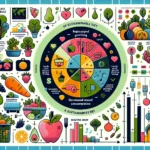The IELTS Reading section tests your ability to comprehend complex texts and answer various question types. Today, we’ll focus on a topic that has become increasingly relevant in modern society: creating a work-life balance plan. This subject has appeared in several IELTS exams over the past few years, reflecting its growing importance in professional and personal spheres. Given its relevance and frequency, there’s a high likelihood that you might encounter a similar passage in your upcoming IELTS test.
Let’s dive into a practice reading passage on this topic, followed by questions that mirror the actual IELTS exam format. This exercise will help you hone your reading skills while exploring a subject that’s crucial for personal well-being and professional success.
 Work-Life Balance Diagram
Work-Life Balance Diagram
Reading Passage
Creating an Effective Work-Life Balance Plan
In today’s fast-paced world, achieving a harmonious work-life balance has become a significant challenge for many professionals. The blurring lines between work and personal life, exacerbated by technological advancements and the rise of remote work, have made it increasingly difficult for individuals to separate their professional and personal spheres. However, establishing a well-structured work-life balance plan is crucial for maintaining both productivity and personal well-being.
The first step in creating an effective work-life balance plan is to conduct a thorough self-assessment. This involves evaluating your current situation, identifying areas of stress or dissatisfaction, and determining your priorities in both work and personal life. It’s essential to be honest with yourself about what truly matters to you and where you feel your time and energy are best spent.
Once you have a clear understanding of your current state and priorities, the next step is to set realistic goals. These goals should encompass both your professional aspirations and personal desires. It’s important to remember that work-life balance doesn’t necessarily mean an equal division of time between work and personal life, but rather a satisfactory integration of the two that aligns with your values and objectives.
Time management plays a crucial role in achieving work-life balance. Implementing effective time management techniques, such as the Pomodoro Technique or time-blocking, can help you allocate your time more efficiently. Additionally, learning to prioritize tasks and say no to non-essential commitments is vital in maintaining balance.
Creating boundaries is another critical aspect of a work-life balance plan. This may involve setting specific work hours, designating a dedicated workspace at home, or establishing rules around checking work emails outside of office hours. Clear boundaries help prevent work from encroaching on personal time and vice versa.
Physical and mental well-being should be integral components of any work-life balance plan. Regular exercise, adequate sleep, and healthy eating habits contribute significantly to overall well-being and productivity. Similarly, incorporating stress-reduction techniques such as meditation or mindfulness practices can help manage work-related stress and improve overall quality of life.
Fostering strong relationships, both personal and professional, is essential for maintaining a healthy work-life balance. This involves dedicating quality time to family and friends, as well as nurturing professional networks. Building a support system can provide emotional support and practical assistance in managing work and personal responsibilities.
Flexibility is key in adapting to changing circumstances and maintaining balance over time. Regularly reviewing and adjusting your work-life balance plan ensures that it remains relevant and effective as your personal and professional situations evolve.
Lastly, it’s important to recognize that achieving perfect work-life balance is an ongoing process rather than a fixed destination. It requires continuous effort, self-reflection, and adaptation. By implementing a well-thought-out work-life balance plan and remaining committed to its execution, individuals can significantly improve their overall quality of life and professional satisfaction.
Questions
True/False/Not Given
- Technology and remote work have made it easier to separate work and personal life.
- A work-life balance plan should aim for an equal division of time between work and personal life.
- The Pomodoro Technique is mentioned as an effective time management strategy.
- Creating boundaries is less important than time management in achieving work-life balance.
- Regular exercise and adequate sleep are mentioned as contributors to overall well-being.
Matching Headings
Match the following headings to the appropriate paragraphs in the passage. There are more headings than paragraphs, so you will not use all of them.
A. The importance of self-assessment
B. Defining work-life balance
C. Setting realistic goals
D. The role of technology in work-life balance
E. Time management techniques
F. Creating boundaries between work and personal life
G. Physical and mental well-being
H. Building relationships and support systems
I. The need for flexibility and ongoing adjustment
Multiple Choice
-
According to the passage, what is the first step in creating a work-life balance plan?
a) Setting realistic goals
b) Implementing time management techniques
c) Conducting a self-assessment
d) Creating boundaries -
Which of the following is NOT mentioned as a component of physical and mental well-being?
a) Regular exercise
b) Adequate sleep
c) Healthy eating habits
d) Regular vacations -
The passage suggests that work-life balance is:
a) Easily achievable with the right plan
b) A fixed state once attained
c) An ongoing process requiring continuous effort
d) Only important for certain professions
Short Answer Questions
Answer the following questions using NO MORE THAN THREE WORDS from the passage for each answer.
- What technique is mentioned alongside time-blocking as an effective time management strategy?
- What should individuals learn to say to non-essential commitments?
- What type of practices are suggested to help manage work-related stress?
Answer Key
True/False/Not Given
- False
- False
- True
- Not Given
- True
Matching Headings
Paragraph 2: A
Paragraph 3: C
Paragraph 4: E
Paragraph 5: F
Paragraph 6: G
Paragraph 7: H
Paragraph 8: I
Multiple Choice
- c
- d
- c
Short Answer Questions
- Pomodoro Technique
- (say) no
- meditation (or) mindfulness practices
Explanations
True/False/Not Given
- False – The passage states that technology and remote work have made it “increasingly difficult for individuals to separate their professional and personal spheres.”
- False – The text explicitly states that work-life balance “doesn’t necessarily mean an equal division of time between work and personal life.”
- True – The Pomodoro Technique is directly mentioned as an example of an effective time management technique.
- Not Given – The passage does not compare the importance of creating boundaries and time management.
- True – The passage explicitly mentions “Regular exercise, adequate sleep, and healthy eating habits” as contributors to overall well-being.
Matching Headings
The correct headings are matched based on the main idea of each paragraph. For example, paragraph 2 focuses on self-assessment, which aligns with heading A.
Multiple Choice
- c – The passage states, “The first step in creating an effective work-life balance plan is to conduct a thorough self-assessment.”
- d – Regular vacations are not mentioned in the list of components for physical and mental well-being.
- c – The last paragraph states that work-life balance is “an ongoing process rather than a fixed destination” and “requires continuous effort, self-reflection, and adaptation.”
Short Answer Questions
- The Pomodoro Technique is explicitly mentioned alongside time-blocking.
- The passage advises “learning to prioritize tasks and say no to non-essential commitments.”
- “Meditation or mindfulness practices” are suggested as stress-reduction techniques.
Common Mistakes
- Misinterpreting “Not Given” statements: Remember, “Not Given” means the information is neither confirmed nor denied in the text.
- Overlooking specific details: Pay close attention to precise wording, such as “doesn’t necessarily mean” in the explanation of work-life balance.
- Bringing external knowledge: Rely solely on the information provided in the passage, not your personal understanding of the topic.
- Time management: Spending too much time on difficult questions can lead to not completing all questions.
Vocabulary
- Harmonious (adjective) /hɑːrˈmoʊniəs/ – forming a pleasing or consistent whole
- Exacerbated (verb) /ɪɡˈzæsərbeɪtɪd/ – made worse
- Spheres (noun) /sfɪərz/ – areas of activity or interest
- Thorough (adjective) /ˈθʌrə/ – complete with regard to every detail
- Dissatisfaction (noun) /ˌdɪsˌsætɪsˈfækʃn/ – lack of satisfaction
- Aspirations (noun) /ˌæspəˈreɪʃnz/ – hopes or ambitions of achieving something
- Encroaching (verb) /ɪnˈkroʊtʃɪŋ/ – gradually taking away rights or opportunities
- Integral (adjective) /ˈɪntɪɡrəl/ – necessary and important as a part of a whole
Grammar Points
- Use of present perfect tense: “has become” indicates an action that started in the past and continues to the present.
- Conditional sentences: “By implementing… individuals can improve” shows a cause-effect relationship.
- Gerunds as subjects: “Creating boundaries is another critical aspect” uses the -ing form as a noun.
- Parallel structure: “Regular exercise, adequate sleep, and healthy eating habits” maintains consistency in list items.
Tips for High IELTS Reading Scores
- Practice active reading: Engage with the text by underlining key points and making mental summaries.
- Improve your vocabulary: Regularly learn new words and their contextual usage.
- Time management: Allocate your time wisely across all sections of the reading test.
- Skim and scan effectively: Quickly identify relevant information without reading every word.
- Practice various question types: Familiarize yourself with all IELTS reading question formats.
- Read widely: Expose yourself to various topics and writing styles to improve comprehension.
- Focus on keywords: Pay attention to qualifying words like “some,” “always,” or “never.”
- Don’t panic if you encounter unfamiliar topics: The answers are always in the text.
Remember, consistent practice and a strategic approach are key to achieving a high score in the IELTS Reading section. Good luck with your preparation!
For more IELTS Reading practice and tips, check out our articles on the importance of work-life boundaries and how to create a balanced work environment.


